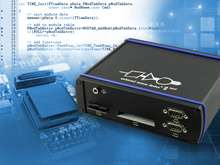 |
 |

Main Menu
Newsletter
News Area
Info Area
Weblinks
Product Focus

Readers Top 5 News of last 30 days
- 27 March 2024 - GPP 5G Conformance Test Solutions with small Footprint
- 21 March 2024 - Stackable High Voltage Measurement Modules
- 22 March 2024 - Decode, Trigger & Search Support for the CAN XL Protocol
- 25 March 2024 - Debug and Trace Support for new Arm Automotive CPUs
- 03 April 2024 - 5-in-1 Programmable Oscilloscopes
News - Service/Maintenance Test
Debugging and Runtime Monitoring of high-end SoCs
 31 January 2020 – PLS Programmierbare Logik & Systeme launches a new version of its Universal Debug Engine (UDE). The new UDE 5.2 offers some completely new functions and a lot of optimizations for even more convenient and efficient debugging.For example, trace functions for data transfers between the six Arm Cortex-R52 cores, special CPUs and peripherals are now also supported for the Stellar automotive microcontroller family from STMicroelectronics.
31 January 2020 – PLS Programmierbare Logik & Systeme launches a new version of its Universal Debug Engine (UDE). The new UDE 5.2 offers some completely new functions and a lot of optimizations for even more convenient and efficient debugging.For example, trace functions for data transfers between the six Arm Cortex-R52 cores, special CPUs and peripherals are now also supported for the Stellar automotive microcontroller family from STMicroelectronics.
In addition, the extended trace functions of UDE 5.2 also allow data transfers via Networks-on-Chip (NoC) to be observed for the first time. These networks are increasingly being used to ensure efficient and flexible data transmission on the chip in highly complex, high-end microcontroller systems. In parallel, a conventional code trace of one or more cores can of course also be performed. Thus, for the first time, the UDE allows the evaluation of the overall system behavior of these new microcontrollers. Moreover, a trace analysis, specially optimized for the Arm CoreSight ETM v4, is used for the core trace, which offers an intelligent correlation of related data and instruction trace. This greatly simplifies the subsequent evaluation of the recorded trace information by the user. Furthermore, trace functions for the Bosch Generic Timer Module (GTM) are now also available especially for the Stellar family.
The extensive debug functions of the Universal Debug Engine (UDE) are not only available for STMicroelectronics’s Stellar MCU family. Other current MCUs are also supported, such as for example, the new AURIX TC33 and TC36 devices from Infineon, the high-performance STM32H7 MCU and the latest SPC58 E-line multi-core automotive MCUs from STMicroelectronics as well as new controllers of the RH850 family and the R-Car H3 from Renesas.
Furthermore, add-ons for Real Time Operating System (RTOS) awareness of the latest FreeRTOS and SafeRTOS operating system versions can also be integrated into UDE for development of real-time critical applications under the control of real-time operating systems. These add-ons provide developers with all the necessary information of the operating systems such as tasks, queues, semaphores / mutexes or timers in a well-structured form. A further add-in is available for the PXROS-HR real-time operating system from HighTec and provides a detailed overview of its objects and the status.
Additionally, in terms of functionality and ease of use, the latest version of the UDE meets a whole range of special customer requirements. For example, the management of software projects with many source code paths has been revised and further optimized. It now allows not only an unlimited number of path replacement rules for source files, but also the exclusion of complete source paths. This is useful, for example, if software libraries are used for which no source code is available. Furthermore, the breakpoint management is also presented in a completely new outfit in UDE. All breakpoints in code as well as data breakpoints are now accessible for the developer in a central window in UDE and can thus be changed even more quickly and conveniently. This central breakpoint window also plays an important role when dealing with multicore breakpoints, which can be used in code shared by multiple cores. Here the user can select those cores which should react to the set multicore breakpoint and thus should stop synchronously.
The UDE 5.2 also supports software debugging via the Universal Measurement and Calibration Protocol (XCP Version 1.5), which was defined by the Association for Standardization of Automation and Measuring Systems (ASAM) as an associated standard to the actual XCP. Precisely for the development of automotive applications in the powertrain domain, this debug channel offers the great advantage that both the UDE and measurement and calibration tools can communicate simultaneously and conflict-free with the ECU without additional hardware effort. A time-consuming change of tools, which would otherwise have relied on one and the same debug interface on the control unit, is therefore no longer necessary.
PLS now also offers a Range Extender for the UAD2next access device from the Universal Access Devices (UAD) family. With this Range Extender, now the UAD2next can also be used at testing stations where distances of up to two meters have to be bridged between the debugger access device and the system under test. The differential signal transmission between Range Extender and UAD2next also makes this solution robust against electromagnetic interference. For the actual connection to the debug interface of the microcontroller, standard target adapters are used which are connected directly to the Range Extender. This means that the extender itself is not target-specific and can therefore be used universally for various debug interfaces such as DAP, SWD, JTAG, cJTAG and LPD. The Range Extender itself only has the size of a standard target adapter and a 40-pin flat ribbon cable transmits the signals to the UAD2next.
www.pls-mc.com/
Related Articles:

Upcoming Events
More events...
See our Trade Show Calendar
Click here
Tag Cloud
© All about Test 2018
 How to resolve AdBlock issue?
How to resolve AdBlock issue?